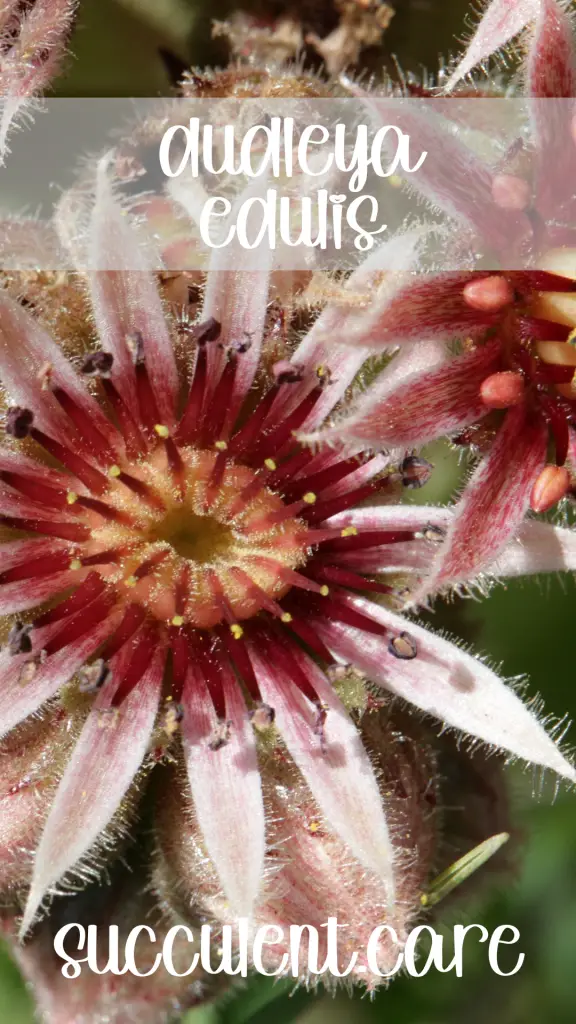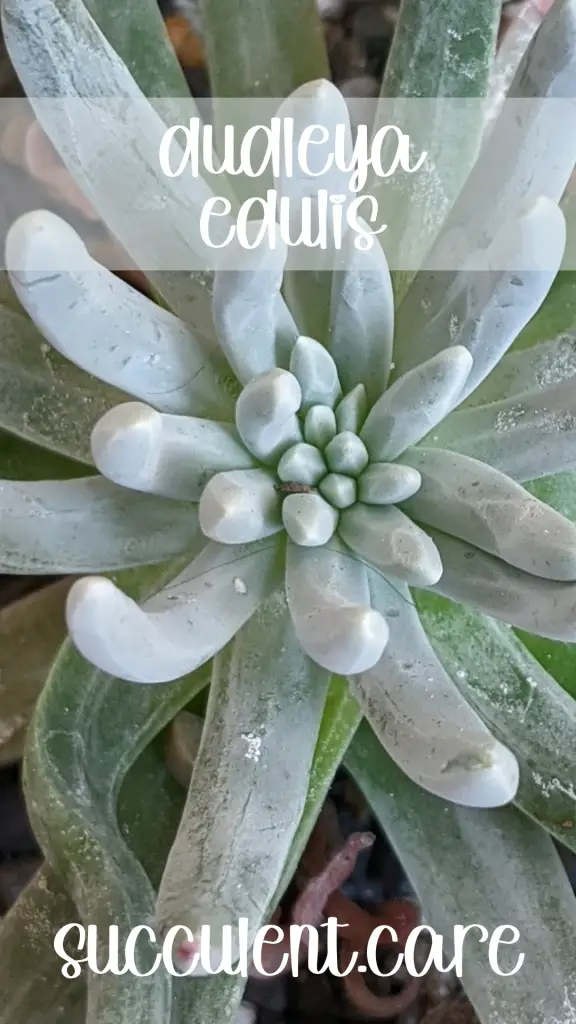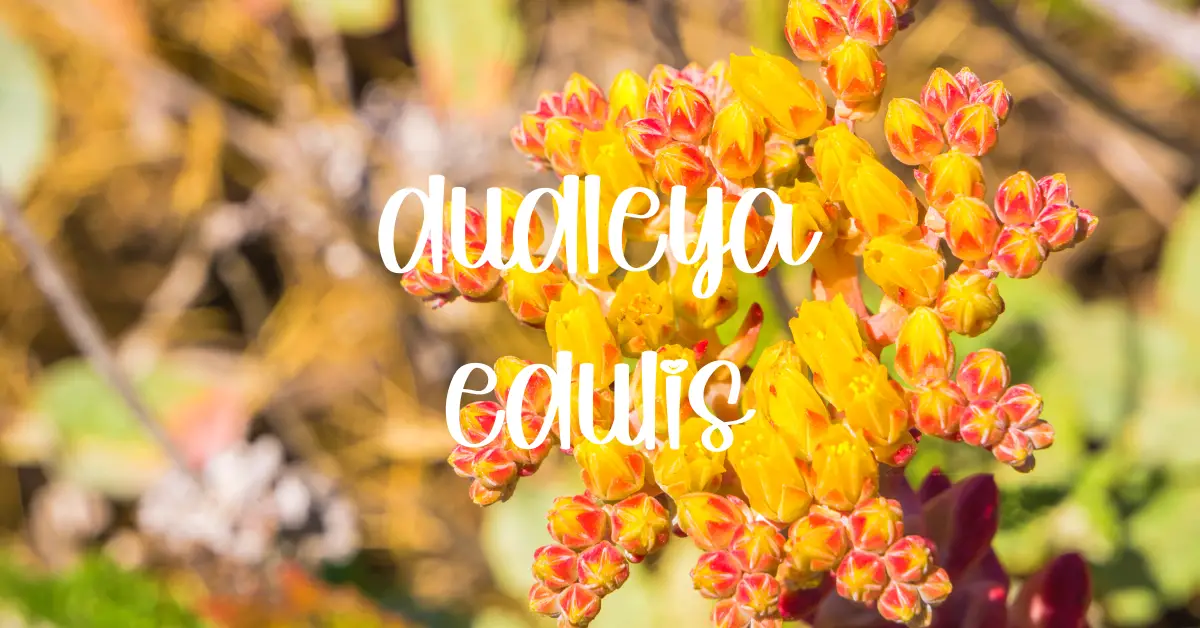Dudleya edulis, also known as the Liveforever plant, is a unique and beautiful succulent that is native to California. These plants are known for their rosettes of thick, fleshy leaves and their ability to thrive in harsh, dry environments. If you’re interested in growing and maintaining Dudleya edulis plants, here are some tips to keep in mind.
California Native Succulent
Dudleya edulis is native to California. These plants can be found along the coast in rocky areas, such as cliffs and bluffs, as well as in chaparral and coastal scrub habitats. They are adapted to survive in harsh, dry environments and can tolerate prolonged periods of drought. Dudleya edulis plants typically grow in areas with well-draining soil and full sun to partial shade exposure. They are often found in association with other succulent and drought-tolerant plant species.
Threatened Species
Dudleya edulis plants are threatened by habitat loss and human development, as well as by the collection of plants from the wild for horticultural purposes. Some Dudleya edulis populations are protected by state and federal laws, and it is important to respect these laws and not collect plants from the wild. Instead, consider purchasing plants from a reputable nursery or propagating your own plants from offsets or stem cuttings. By protecting and preserving natural habitats, we can help ensure the continued survival of these unique and beautiful succulents.
Fun Fact About Dudleya Edulis
One other interesting fact about Dudleya edulis plants is that they are known to have a symbiotic relationship with a species of bumblebee called Bombus vosnesenskii, also known as the yellow-faced bumblebee. These bumblebees are the primary pollinators of Dudleya edulis plants and play a crucial role in their reproductive success. The bumblebees collect nectar from the flowers of the plant and in turn help to spread pollen and fertilize the flowers, leading to the production of seeds. This mutualistic relationship benefits both the plants and the bumblebees, and is an example of the complex and interconnected web of life in which we all live.f

Where to Buy Succulents Online
Watering Dudleya Edulis
One of the most important aspects of Dudleya edulis care is watering. These plants are drought-tolerant and do not need frequent watering, but they do require some moisture to survive.
To water Dudleya edulis, follow these 3 simple steps:
- Wait until the soil is dry. Dudleya edulis plants do not like to sit in wet soil, so it’s important to wait until the soil is dry before watering. This can vary depending on the size of the pot, the soil mix, and the humidity and temperature in your area. As a general rule, you should wait until the soil is dry to a depth of about 1 inch.
- Water thoroughly: When you do water your Dudleya edulis plant, be sure to water it thoroughly. This means applying enough water to moisten the entire root zone, but not so much that the soil becomes waterlogged.
- Don’t let the plant sit in standing water. After watering, be sure to drain any excess water from the pot or tray to prevent the plant from sitting in standing water.

Sunlight for Dudleya Edulis
Dudleya edulis care means giving plenty of sunlight to thrive. They can also be susceptible to sunburn if exposed to too much direct sunlight. To ensure that your Dudleya edulis plant is getting the right amount of sunlight, follow these tips:
- Provide bright, indirect light: Dudleya edulis plants prefer bright, indirect light rather than direct sunlight. A south-facing window is often a good location for these plants, as it provides plenty of light without being too intense.
- Avoid exposing the plant to intense, direct sunlight. If your Dudleya is exposed to intense, direct sunlight for extended periods of time, it may become sunburnt, which can cause the leaves to become discolored or shriveled. To prevent sunburn, try to provide some shade or protection for the plant during the hottest times of the day.

Propagating Dudleya Edulis
There are two main methods for propagating Dudleya edulis plants: offsets and stem cuttings.
Propagating Through Offsets
Offsets are small plants that grow near the base of the parent plant. These offsets can be easily removed and potted to create new Dudleya edulis plants.
To propagate your plant through offsets, follow these steps:
- Locate the offsets. Look for small plants growing near the base of the parent plant. These are the offsets that can be used for propagation.
- Carefully remove the offsets. Using a sharp, clean knife or scissors, cut the offsets away from the parent plant. Be sure to cut as close to the base of the offset as possible, while still leaving a small amount of stem attached.
- Allow the offsets to callous. Place the offsets on a clean surface and allow them to sit for a few days to allow the cut ends to callous over and form a protective layer.
- Pot the offsets. Fill a small pot with well-draining soil mix. Then gently press the offset into the soil so that the calloused end is in contact with the soil. Water the soil gently to moisten it. Cover the pot with a plastic bag or propagator lid to create a humid environment.
- Monitor and care for the offsets. Keep the soil moist but not wet, and provide the offsets with plenty of light. Once they have developed a few sets of leaves, you can transplant them into individual pots or the garden.
Propagating Through Stem Cuttings
Stem cuttings are another method of propagating Dudleya edulis succulents.
To propagate your Dudleya through stem cuttings, follow these steps:
- Select a healthy, mature plant. Choose a Dudleya edulis plant that is in good health and has well-developed stems.
- Cut a piece from the plant. Use a sharp, clean knife or scissors to cut a piece of the plant that is at least 3-4 inches long. Make sure to cut below a leaf or stem node, as this is where the new roots will form.
- Allow the cutting to callous. Place the cutting on a clean surface and allow it to sit for a few days to allow the cut end to callous over and form a protective layer.
- Root the cutting. Fill a small pot with well-draining soil mix. Gently press the cutting into the soil so that the calloused end is in contact with the soil. Water the soil gently to moisten it. Cover the pot or tray with a plastic bag or propagator lid to create a humid environment.
- Monitor and care for the cutting. Keep the soil moist but not wet, and provide the cutting with plenty of light. Once it has developed a few sets of leaves, you can transplant it into an individual pot or the garden.
Is Dudleya Edulis Toxic?
Dudleya edulis, also known as the liveforever plant or edible liveforever, is generally considered non-toxic to humans and pets. However, as with any plant, it is possible that some people may experience mild skin irritation or allergic reactions after handling the plant. It is always a good idea to wash your hands after handling any plants, especially if you have sensitive skin.
If you have pets, it is important to keep in mind that they may be more prone to chewing on plants, which can cause digestive issues. While Dudleya edulis is not toxic to pets, it is always a good idea to keep plants out of reach of pets to prevent accidental ingestion.
If you have any concerns about the safety of a plant in your home, it is always a good idea to consult with a veterinarian or a professional in plant care.
Conclusion
Dudleya edulis, also known as the Liveforever plant, is a unique and beautiful succulent that is native to California. These plants are known for their rosettes of thick, fleshy leaves and their ability to thrive in harsh, dry environments. Follow these Dudleya edulis care tips in this guide, you can successfully grow and maintain these plants in your garden. With proper watering, sunlight, and propagation techniques, you can enjoy these attractive and low-maintenance plants for years to come.


